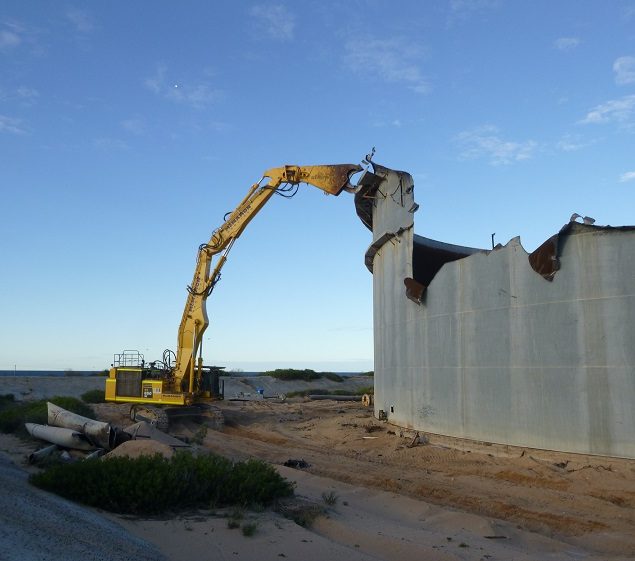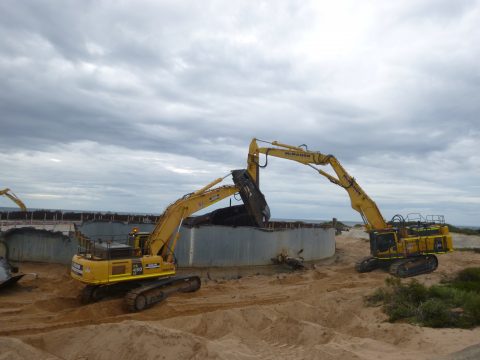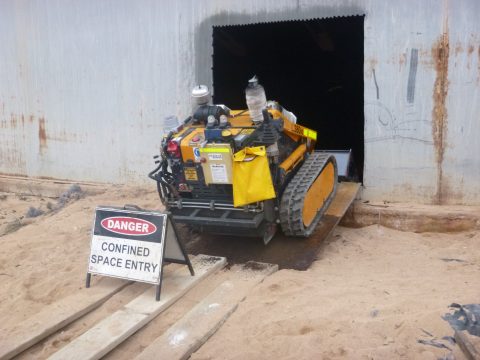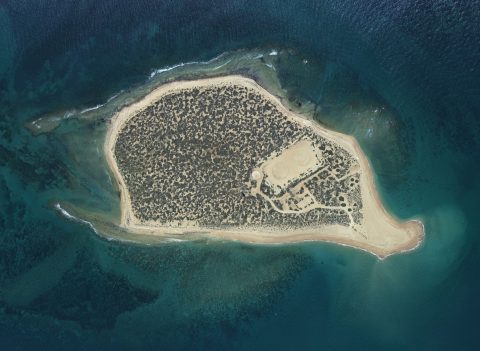McMahon Services’ Western Australia division has delivered a succession of successful projects in the Pilbara region of late, particularly in the demolition and deconstruction space. Many of those projects have been highly challenging to deliver, but perhaps none more so than the Airlie Island Hydrocarbon Storage Tanks and Infrastructure Demolition project for Quadrant Energy.
Airlie is a remote Indian Ocean island situated 35km to the North of Onslow, and it is barely 800m wide by 400m across. It’s flat with nothing on it except for sand, scrub and a former crude oil storage and processing facility built in the 1980s and abandoned in 2002 for economic reasons.
In 2007 the Western Australian Department of Environment Regulation classified the facility under the Contaminated Sites Act 2003 as a “Contaminated Site – Remediation required”. This was due to the presence of active contamination in the vicinity of the two tanks identified during ground water monitoring. The deterioration of the tank roof drains allowed water to mix with the stored hydrocarbons, and the structural integrity of the tanks had also deteriorated.
Phil Bubner, State Manager Western Australia and Project Director for the tank deconstruction project said, “McMahon Services were contracted by Quadrant to remove the oily water and sludge from the two tanks, demolish the tanks and supporting infrastructure, and later as a variation to the contract, remove the contaminated soil from below the tanks.
“To achieve this, we had to bring everything we needed with us to the island, including power, accommodation, plant and equipment, food and water because there is literally nothing there.”
All required equipment and resources were transported from Karratha to site. “We utilised landing craft tanks, or LCTs, to transport equipment over water because of their bow ramps. Low draft gave them the ability to discharge their cargo onto a beach.”
The two tanks to be demolished were 18m high and 46m diameter, with approximately 200mm of hydrocarbon sludge overlayed with approximately 700mm of oily water in one and a smaller quantity in the other.
“Due to the toxic air qualities inside each tank and their unknown structural integrity, it was unsafe to send personnel inside for cleaning. Due to the highly flammable nature of the hydrocarbons, only cold shear attachments could be used for manual deconstruction of the tanks,” said Phil.
“We had to come up with an innovative solution to remove the hydrocarbons without compromising health and safety.”
The first step was to drain 733m3 of oily water from the tanks. The water was pumped into the storage tanks on the underside of the landing craft tanks for shipment to the mainland for treatment and disposal.
Once the oily water was removed, two intrinsically safe remote controlled mini tracked bobcats were used to clean the majority of the sludge from the floor of the tanks. The sludge was pumped into 9,000L intermodal containers and loaded onto the landing craft tanks for transport to Karratha for treatment and final disposal.
An 85t excavator with long reach capability and cold shear attachment was then utilised to manually deconstruct the tanks using a top down approach to 1.5m above the floor level. The next step was to manually remove the floating roofs to allow access for the final clean. Once the final clean was complete and the tanks cleaned with high pressure hot water, the remainder of the tank walls and floor were demolished.
Roof and wall elements were sheared into 1.5m by 1.0m sections for ease of transport. All scrap steel and contaminated sand excavated from under the tanks were each separately loaded into 1.2m high covered intermodal containers which were then loaded onto landing craft tanks for transport to Karratha for further processing. Scrap steel was processed at McMahon Services’ facilities in Karratha for later export overseas.
Phil said of the project when it was complete, “It was a great outcome all round. A good crew. A good team effort. We successfully managed quarantine controls to ensure no non-native flora or fauna species were introduced from the mainland, and protected the nesting homes of sea turtles and the shearwater birds that migrate annually to the island to breed.
“98% of the 2,500t of materials demolished and shipped to the mainland were recycled. There were no lost time or medical treatment injuries. Works were completed on time and on budget. You couldn’t ask for a better project outcome considering the challenging conditions.”
Phil added that the team coped well with living on a tiny island. “For 14 weeks, we ate, rested and slept on a flotel (floating accommodation barge), only coming to the island to work during the day. You can go a little stir-crazy in conditions like that – although we did organise two fishing charters for the guys during the project to alleviate the boredom.
“The team were extremely professional, and worked in some fairly trying conditions to deliver exceptional outcomes.”




